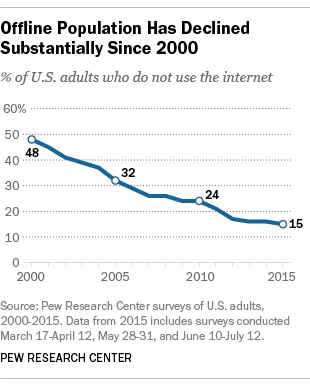Some 15% of adults in the United States do not use the Internet, according to a recent report from the Pew Research Center.
The report was based on data from three surveys of a nationally representative sample of adults living in the United States.
Over time, the offline population has been steadily shrinking, the analysis found. In the year 2000, 48% of Americans did not use the internet, and even as recently as 2010 nearly a quarter (24%) were not online.
For some groups the rise in Internet adoption has been especially pronounced:
- Some 86% of adults age 65 and older did not go online in 2000; in 2015, that figure has been cut in half.
- Among adults without a high school diploma, the proportion not using the Internet dropped from 81% to 33% in the same time period.

Despite a rise in their use of the Internet, seniors remain the group most likely to say they never go online. Some 39% of adults age 65 and older do not use the Internet, compared with only 3% of 18-29-year-olds.
Household income and education are also strongly linked to a person’s likelihood to be offline:
- One-third of adults with less than a high school education do not use the Internet, with that rate steadily falling as educational levels increases
- Adults from households earning less than $30,000 a year are eight times more likely to not use the Internet compared with affluent adults.
Rural Americans are about twice as likely as those who live in urban or suburban areas to never use the Internet.
Racial and ethnic differences are also evident: One-in-five blacks and 18% of Hispanics do not use the Internet, compared with 14% of whites and only 5% of English-speaking Asian-Americans—the racial or ethnic group least likely to be offline.

About the research: The report was based on data from three surveys of a nationally representative sample of adults living in the United States.




